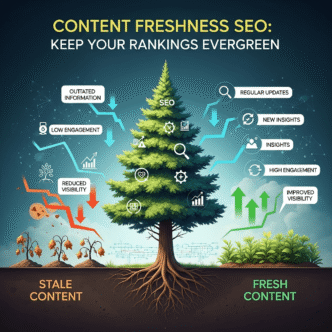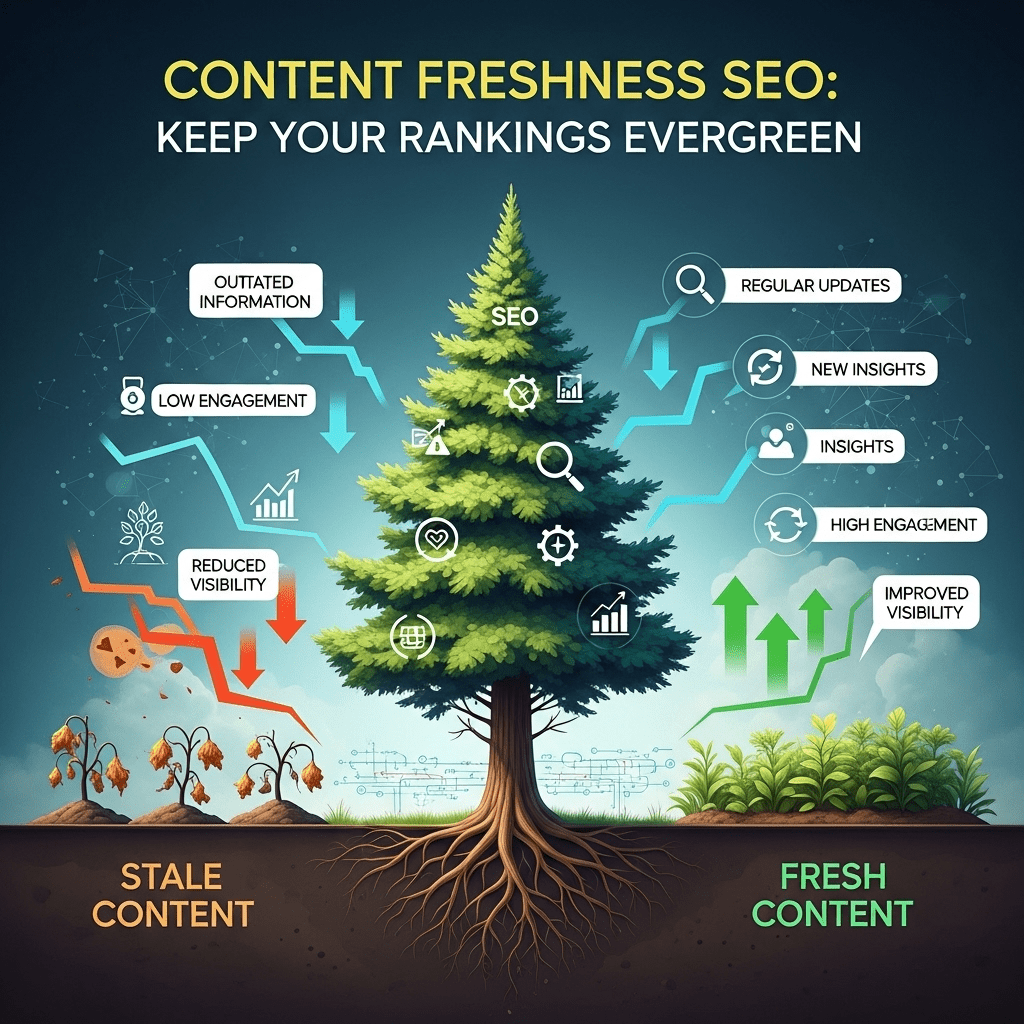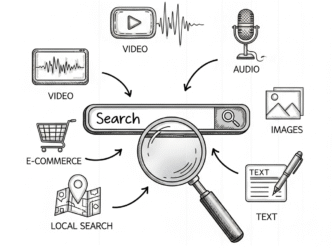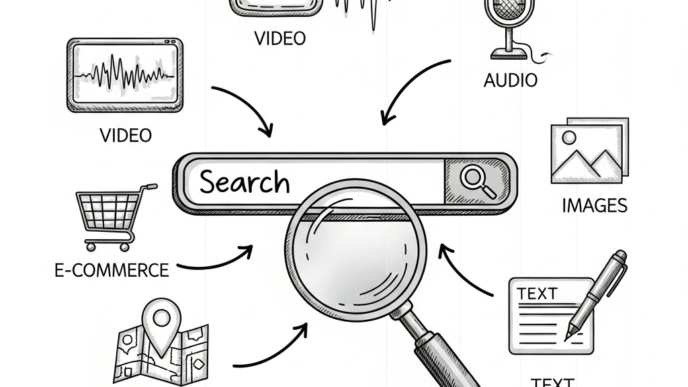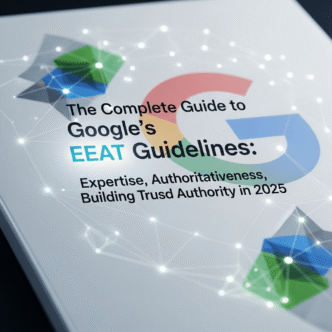Ever noticed how your once-stellar blog post that ranked #1 for months suddenly disappeared from search results? Here’s the harsh reality: content freshness SEO isn’t just a nice-to-have anymore – it’s the difference between maintaining your rankings and watching competitors leapfrog over your “aging” content.
If you’ve been treating your published content like fine wine (hoping it gets better with age), you’re in for a rude awakening. Content freshness SEO has become Google’s way of ensuring users get the most current, accurate, and relevant information available.
The uncomfortable truth? That comprehensive guide you spent weeks perfecting last year might be quietly hemorrhaging rankings while you focus on creating new content. Meanwhile, smart competitors are systematically refreshing their existing content and stealing your hard-earned search positions.
Understanding how content freshness integrates with Google’s comprehensive trust and authority framework isn’t optional – it’s essential for maintaining long-term SEO success.
Table of Contents
Toggle
What Is Content Freshness SEO and Why Your Rankings Depend on It
Content freshness SEO refers to the strategic practice of regularly updating, refreshing, and maintaining existing content to ensure it remains current, accurate, and valuable to users, thereby maintaining or improving search engine rankings over time.
Think of content freshness SEO as your website’s maintenance program. Just like you wouldn’t drive a car for years without an oil change, you can’t expect content to maintain peak performance without regular updates and refreshes.
The data tells a compelling story: websites that regularly refresh their content see 40% better rankings stability compared to those that publish and forget. Meanwhile, outdated content loses an average of 67% of its organic traffic within 2-3 years.
The Freshness Ranking Factor
Google’s Freshness Algorithm: Officially confirmed as a ranking factor, especially for time-sensitive queries and rapidly evolving topics.
QDF (Query Deserves Freshness): Google’s system that determines when fresh content should be prioritized for specific search queries.
Content Decay Reality: All content experiences natural ranking decay over time without proper maintenance and updates.
Pro Tip: “Content freshness isn’t about changing everything – it’s about strategic updates that maintain relevance and accuracy. Think of it as giving your content a spa day: refreshing, rejuvenating, and bringing back that healthy glow that attracts both users and search engines.”
Content Updates That Actually Move the Needle
Understanding which content updates have the biggest impact helps prioritize your refresh efforts for maximum SEO benefit.
High-Impact Update Categories
Statistical Refreshes:
- Update outdated statistics and data points
- Add recent research findings and studies
- Include current industry benchmarks and trends
- Replace old screenshots with current versions
Information Accuracy Improvements:
- Correct any outdated information or recommendations
- Update pricing, features, or product information
- Refresh legal requirements or regulation changes
- Revise best practices based on current standards
Content Expansion and Enhancement:
- Add new sections covering recent developments
- Include additional examples and case studies
- Expand on topics with new insights or techniques
- Integrate user questions and feedback into content
Content Updates Impact Assessment
| Update Type | SEO Impact | Time Investment | Ranking Improvement Potential | Priority Level |
|---|---|---|---|---|
| Statistics Refresh | High | Low | 15-30% | Immediate |
| Accuracy Corrections | Very High | Medium | 20-50% | Critical |
| Content Expansion | High | High | 25-40% | High |
| Visual Updates | Medium | Medium | 10-20% | Medium |
| Internal Link Updates | Medium | Low | 15-25% | High |
| Meta Information | High | Very Low | 20-35% | Immediate |
Information Currency and Google’s Freshness Signals
Information currency has become a critical ranking factor as Google prioritizes content that provides users with the most current and accurate information available.
Freshness Signal Categories
Publication Date Indicators:
- Last modified dates prominently displayed
- Article timestamps and update notifications
- Content versioning and revision history
- Publication schedule consistency
Content Currency Markers:
- Recent statistics and data references
- Current event mentions and relevance
- Updated screenshots and visual examples
- Fresh external link references
Topical Relevance Signals:
- Coverage of recent industry developments
- Integration of trending topics and discussions
- Response to current events and changes
- Alignment with seasonal or temporal relevance
Real-World Case Study: HubSpot’s Content Refresh Strategy
HubSpot demonstrates exceptional fresh content strategy through systematic content maintenance:
Monthly Content Audits: Regular review of top-performing content for update opportunities.
Statistical Updates: Quarterly refresh of all statistics and data points across their content library.
Expansion Strategy: Adding new sections to existing popular content rather than creating entirely new pieces.
Performance Tracking: Monitoring which refreshed content sees the biggest ranking improvements.
Results: Maintained top rankings for competitive marketing terms while seeing 60% better engagement on refreshed content.
Key Insight: Their systematic approach to content freshness has helped them maintain authority in a rapidly evolving digital marketing landscape.
Fresh Content Strategy for Sustainable Rankings
A comprehensive fresh content strategy balances creating new content with maintaining and optimizing existing high-performing pieces.
Strategic Content Refresh Framework
Content Audit and Prioritization:
- Identify content with declining rankings or traffic
- Prioritize high-traffic pages with refresh potential
- Focus on evergreen content that can benefit from updates
- Target content ranking on page 2-3 with improvement potential
Update Planning and Execution:
- Create content refresh calendars and schedules
- Assign specific team members to content maintenance tasks
- Develop standardized processes for different update types
- Implement quality control and review procedures
Performance Monitoring and Optimization:
- Track ranking changes after content updates
- Monitor traffic and engagement improvements
- Analyze user feedback and behavior changes
- Refine refresh strategies based on performance data
Understanding how this strategy supports Google’s broader authority and trust evaluation ensures comprehensive SEO success.
Content Maintenance Best Practices
Effective content maintenance requires systematic approaches that ensure all content remains current, accurate, and valuable over time.
Maintenance Schedule Framework
Monthly Reviews:
- Check for broken links and fix any technical issues
- Update time-sensitive information and statistics
- Review and respond to user comments and feedback
- Monitor performance metrics and ranking changes
Quarterly Deep Refreshes:
- Comprehensive content audits for accuracy and relevance
- Major statistical updates and data refreshes
- Content expansion with new sections or insights
- Visual content updates and screenshot replacements
Annual Strategic Overhauls:
- Complete content restructuring if needed
- Major topic expansion and comprehensive updates
- Competitive analysis and gap identification
- Strategic redirect and consolidation decisions
Maintenance Prioritization Matrix
High Priority (Update Immediately):
- Content with factual errors or outdated information
- Pages with broken functionality or major technical issues
- High-traffic content with declining performance
- Content with legal or compliance implications
Medium Priority (Update Within 30 Days):
- Content with outdated statistics or examples
- Pages with minor technical issues or improvements needed
- Medium-traffic content with refresh potential
- Content with outdated screenshots or visuals
Low Priority (Update Within 90 Days):
- Content with minor improvements or enhancements possible
- Low-traffic content with limited refresh impact
- Stylistic updates and formatting improvements
- Content consolidation and reorganization opportunities
How to Update Old Content for Rankings That Actually Work
How to update old content for rankings requires strategic approaches that signal freshness to search engines while genuinely improving user value.
Content Refresh Methodology
Step 1: Performance Analysis
- Review current rankings and traffic for target content
- Identify specific areas where content is outdated or incomplete
- Analyze competitor content to identify gaps and opportunities
- Assess user engagement metrics and feedback
Step 2: Strategic Update Planning
- Prioritize updates that will have the biggest SEO impact
- Plan content expansion that adds genuine value
- Identify opportunities for improved internal linking
- Schedule updates to minimize disruption to current rankings
Step 3: Implementation and Optimization
- Update content systematically while maintaining overall structure
- Add new sections that enhance comprehensiveness
- Refresh meta titles and descriptions with current focus keywords
- Implement proper redirect strategies if URL changes are needed
Content Update Techniques That Work
The “Sandwich Method”: Add new, current information between existing content sections to maintain overall structure while providing fresh insights.
The “Expansion Strategy”: Build upon existing content with additional sections covering recent developments or advanced topics.
The “Statistical Refresh”: Systematically update all data points, statistics, and examples throughout the content.
The “Visual Overhaul”: Replace outdated screenshots, graphics, and visual elements with current versions.
Outdated Content Optimization Strategies
Outdated content optimization transforms aging content into fresh, relevant resources that can reclaim and improve search rankings.
Optimization Assessment Framework
Content Age and Relevance:
- Publication date and last update timeline
- Topic evolution and industry changes since publication
- Current search intent alignment and user needs
- Competitive landscape changes and new players
Technical and Performance Issues:
- Page loading speed and technical optimization
- Mobile responsiveness and user experience
- Internal and external link quality and functionality
- Conversion optimization and call-to-action effectiveness
Content Quality and Completeness:
- Information accuracy and factual correctness
- Content depth and comprehensiveness
- User engagement metrics and satisfaction indicators
- Search ranking performance and traffic trends
Optimization Priority Framework
| Content Category | Optimization Approach | Expected Results | Timeline |
|---|---|---|---|
| High-Traffic Declining | Comprehensive refresh with expansion | 30-60% traffic recovery | 2-4 weeks |
| Medium-Traffic Stable | Statistical updates and improvements | 15-25% performance boost | 1-2 weeks |
| Low-Traffic Potential | Major overhaul or consolidation | 50-100% improvement | 4-6 weeks |
| Outdated High-Value | Complete rewrite with current focus | 40-80% ranking improvement | 3-5 weeks |
Content Refresh Tactics for Different Content Types
Different content types require specialized content refresh tactics to maximize their freshness and SEO impact.
Blog Post Refresh Strategies
Evergreen Content Updates:
- Add current examples and case studies
- Update statistical data and research references
- Expand with new insights and techniques
- Refresh internal linking to newer related content
News and Trend Content:
- Add follow-up sections with recent developments
- Update with current status and changes
- Link to related recent content and discussions
- Adjust focus based on topic evolution
How-To and Tutorial Content:
- Update screenshots and step-by-step instructions
- Add new methods or tools that have emerged
- Include troubleshooting for common current issues
- Expand with advanced techniques and variations
Resource and Guide Refresh Approaches
Comprehensive Guide Updates:
- Add new chapters or sections covering recent developments
- Update all examples and case studies with current versions
- Refresh tool recommendations and feature comparisons
- Expand depth based on user questions and feedback
Resource List Maintenance:
- Remove defunct tools and resources
- Add new, better alternatives and options
- Update pricing and feature information
- Reorganize based on current user priorities and needs
For comprehensive guidance on integrating content freshness with overall authority building, explore our detailed framework for maintaining trust and relevance over time.
Information Accuracy and Trust Building
Information accuracy has become critical for maintaining user trust and search engine credibility as misinformation concerns grow.
Accuracy Maintenance Strategies
Fact-Checking Processes:
- Regular verification of all statistical claims and data points
- Cross-referencing information with authoritative sources
- Implementation of correction processes for identified errors
- Transparent update logs showing changes and improvements
Source Quality Management:
- Regular review of external link destinations and quality
- Replacement of broken or outdated reference links
- Addition of more authoritative and recent source materials
- Verification of citation accuracy and relevance
Expert Review Integration:
- Periodic review by subject matter experts
- Professional fact-checking for complex or technical topics
- Industry professional feedback and validation
- Academic or professional peer review when appropriate
Accuracy Impact on SEO
Trust Signal Enhancement: Accurate information builds user trust, which Google recognizes through engagement metrics.
Authority Building: Consistently accurate content establishes topical authority and expertise signals.
User Experience Improvement: Accurate information reduces bounce rates and increases time on page.
Link Attraction: Other sites are more likely to link to reliable, accurate content sources.
Maintaining Content Relevancy Over Time
Maintaining content relevancy over time requires proactive strategies that anticipate and respond to changing user needs and industry evolution.
Relevancy Monitoring Framework
Industry Trend Tracking:
- Monitor industry publications and thought leadership content
- Track emerging tools, techniques, and best practices
- Follow regulatory changes and compliance updates
- Observe competitive content strategies and innovations
User Behavior Analysis:
- Analyze search query evolution and intent changes
- Monitor user comments and feedback for content gaps
- Track engagement metrics and user satisfaction indicators
- Survey audience needs and content preferences
Performance Metric Monitoring:
- Regular ranking position tracking for target keywords
- Traffic trend analysis and decline identification
- Conversion rate monitoring and optimization opportunities
- Competitive ranking analysis and gap identification
Relevancy Enhancement Techniques
Topic Expansion: Add coverage of related topics that have become important to your audience.
Format Diversification: Add videos, infographics, or interactive elements to enhance engagement.
Current Event Integration: Connect evergreen content to current events and trending discussions.
User-Generated Integration: Incorporate user questions, comments, and feedback into content updates.
Understanding how relevancy maintenance supports comprehensive SEO authority building ensures long-term content success.
Content Freshness Strategies for Better SEO Implementation
Content freshness strategies for better SEO require systematic implementation that balances efficiency with effectiveness.
Implementation Framework
Phase 1: Content Audit and Assessment
- Comprehensive inventory of all existing content
- Performance analysis and ranking trend identification
- Competitive analysis and gap assessment
- Priority ranking based on impact potential
Phase 2: Refresh Strategy Development
- Create content update calendars and schedules
- Assign team responsibilities and accountability
- Develop standardized update processes and checklists
- Establish quality control and review procedures
Phase 3: Systematic Update Execution
- Begin with highest-priority, highest-impact content
- Implement updates systematically with performance tracking
- Monitor ranking and traffic changes after updates
- Refine processes based on results and learning
Phase 4: Ongoing Maintenance and Optimization
- Establish regular content review and update cycles
- Continuously monitor performance and competitive changes
- Adapt strategies based on algorithm updates and industry evolution
- Scale successful approaches across larger content volumes
Tools and Resources for Content Freshness
Content Management Tools:
- Editorial calendars for scheduling updates and reviews
- Content audit spreadsheets for tracking refresh status
- Performance monitoring dashboards for impact measurement
- Collaboration tools for team coordination and accountability
SEO and Analytics Tools:
- Google Analytics for traffic and engagement tracking
- Google Search Console for ranking and click-through monitoring
- SEMrush or Ahrefs for competitive analysis and opportunity identification
- PageSpeed Insights for technical performance monitoring
Content Refresh Best Practices for Maximum Impact
Content refresh best practices ensure that update efforts produce measurable improvements in rankings and user engagement.
Best Practice Framework
Strategic Planning:
- Focus on content with proven performance history
- Prioritize updates that address current user needs
- Balance comprehensive updates with quick wins
- Plan updates during low-traffic periods when possible
Execution Excellence:
- Maintain content structure and URL consistency when possible
- Update publication dates to reflect significant changes
- Improve internal linking to and from refreshed content
- Optimize meta information to reflect updated content focus
Quality Assurance:
- Proofread all updated content for errors and consistency
- Test all links and functionality after updates
- Verify mobile responsiveness and user experience
- Confirm that updates maintain or improve page loading speed
Refresh Success Metrics
Immediate Impact Indicators (1-4 weeks):
- Improved indexing and crawling by search engines
- Ranking position improvements for target keywords
- Increased click-through rates from search results
- Enhanced user engagement metrics
Long-term Success Measures (2-6 months):
- Sustained ranking improvements and stability
- Increased organic traffic and user acquisition
- Higher conversion rates and goal completions
- Improved brand authority and recognition
Keeping Content Current for Google Algorithm Changes
Keeping content current for Google requires understanding and adapting to algorithm updates and ranking factor evolution.
Algorithm Adaptation Strategies
Core Algorithm Updates:
- Monitor official Google communications and guidance
- Analyze ranking changes after major algorithm updates
- Adjust content strategies based on confirmed ranking factor changes
- Maintain focus on user value and satisfaction
Emerging Ranking Factors:
- Stay informed about new ranking factors and their implementation
- Adapt content strategies to incorporate new optimization opportunities
- Test new techniques and measure their impact on performance
- Share learning and insights with the broader SEO community
Industry Evolution Response:
- Monitor industry trend changes and user behavior evolution
- Adapt content topics and focus areas based on changing user needs
- Incorporate new tools, techniques, and best practices into content
- Maintain thought leadership through early adoption and testing
Common Content Refresh Tactics Mistakes to Avoid
Understanding common mistakes helps avoid wasted effort and potential ranking damage during content refresh initiatives.
The “Change Everything” Trap
Mistake: Making dramatic changes to successful content without strategic reasoning. Better Approach: Focus on strategic improvements that enhance rather than replace successful elements.
The “Cosmetic Only” Problem
Mistake: Making only surface-level changes without addressing core content issues. Better Approach: Combine visual updates with substantial content improvements and value additions.
The “Timing Disaster” Issue
Mistake: Publishing major updates during high-traffic periods or without proper testing. Better Approach: Schedule updates strategically and test thoroughly before publication.
The “No Follow-Up” Error
Mistake: Updating content and forgetting to monitor performance and make additional improvements. Better Approach: Implement systematic follow-up and continuous improvement processes.
Pro Tip: “The biggest content freshness mistake is treating updates as one-time events instead of ongoing processes. Content freshness is like fitness – you can’t work out once and expect to stay in shape forever. Consistent, strategic maintenance beats sporadic major overhauls.”
Mastering content freshness SEO isn’t just about maintaining rankings – it’s about building a sustainable competitive advantage through consistent value delivery and user satisfaction.
The Freshness Reality Check
The Truth: Content decay is inevitable, but content death is optional with proper maintenance and strategic refreshing.
The Opportunity: Most websites publish and forget, creating massive opportunities for those who consistently maintain and improve their content.
The Investment: Content freshness requires ongoing effort, but it’s far more cost-effective than constantly creating new content from scratch.
Success Principles for Freshness Mastery
Quality Over Quantity: Better to maintain fewer pieces of content excellently than many pieces poorly.
Strategic Over Random: Focus refresh efforts on content with proven performance and improvement potential.
User Value Over SEO Tricks: Always prioritize genuine user value when making content updates and improvements.
Consistency Over Intensity: Regular, systematic content maintenance beats sporadic major overhauls.
Your Content Freshness Success Formula
Regular Updates + Strategic Improvements + User Focus + Performance Monitoring = Evergreen Rankings
The websites that dominate search results long-term aren’t just those with the best new content – they’re those that continuously maintain and improve their existing content library to stay current, relevant, and valuable.
Your existing content is your most valuable SEO asset. Stop letting it age gracefully and start helping it age strategically. With proper content freshness strategies, your best content can maintain and improve its rankings for years to come.
The question isn’t whether content freshness affects SEO – it’s whether you’re ready to make content maintenance a core part of your SEO strategy.
Start refreshing your content today. Your rankings, traffic, and long-term SEO success depend on it.
This comprehensive guide on content freshness SEO provides proven strategies for maintaining and improving content performance through strategic updates and maintenance in 2025.

